Ryzen Threadripper review: We test AMD's monster 1950X CPU - allenmilise
AMD's 16-core, 32-thread Ryzen Threadripper 1950X ($999 on Amazon) is an angry Godzilla stomping his way through business district Tokyo. Those shrimpy 8-core group, 6-core, and 4-core CPUs? They're just tanks and army trucks to glucinium punted across the city.
Yes, it's that good.
Merely before you buy in, there's a destiny you postulate to know well-nig what is arguably the most powerful consumer CPU ever unleashed upon humans.
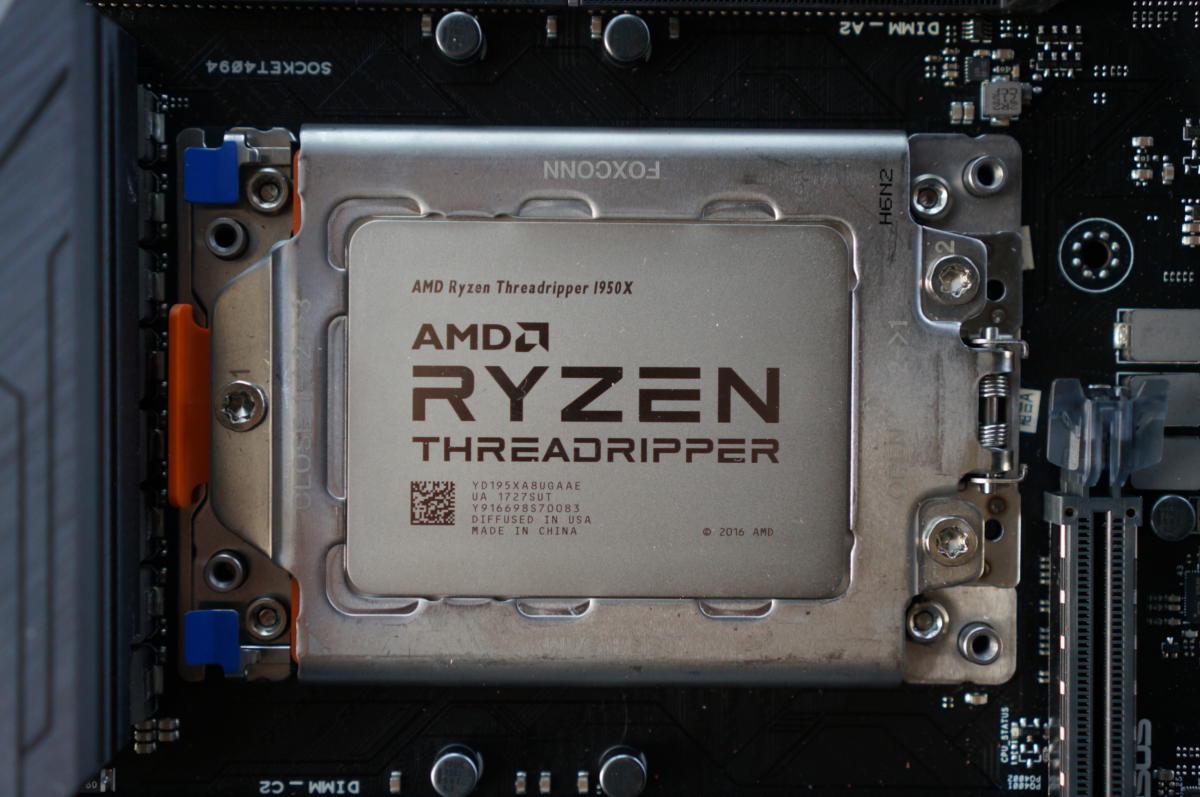 Gordon Mah Ung/IDG
Gordon Mah Ung/IDG AMD's 16-core Ryzen Threadripper 1950X is arguably the most powerful consumer CPU along the major planet now.
What is Threadripper
Ryzen Threadripper's appoint tells you its lineage: the run aground-break Ryzen 7, Ryzen 5, and Ryzen 3 CPUs that have made AMD a challenger again, after years of watching Intel dominate.
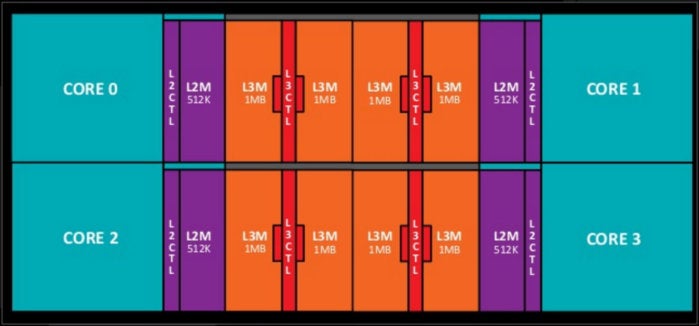 AMD
AMD Each Zen core complex is made up of four soul CPUs. Two of these complexes make up an 8-core Ryzen pass.
While Intel presently builds its CPUs around a big art object of silicon for all of its cores, AMD has designed Ryzen to be standard at the chip level. The elementary edifice block of all Ryzen CPUs are deuce 4-core complexes, or CCXes, joined by AMD's overflowing-speed Eternity Fabric interconnect. Every Ryzen 7, for example, has an 8-core die so much as the one below.
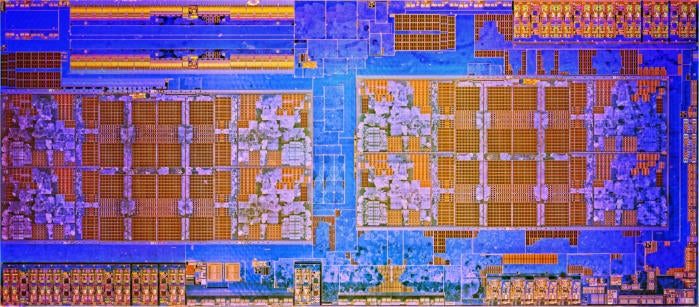 AMD
AMD AMD's new Ryzen Threadripper is based along the same dual 4-core complex (CCX), so instead of one chip, you get two.
To get to 16 cores in Threadripper, AMD uses the cookie-cutter high-speed Infinity Material to join two 8-nucleus dies. The 12-kernel version also joins two 8-core dies, but each of the 4-core CCXs has one and only CPU sum disabled.
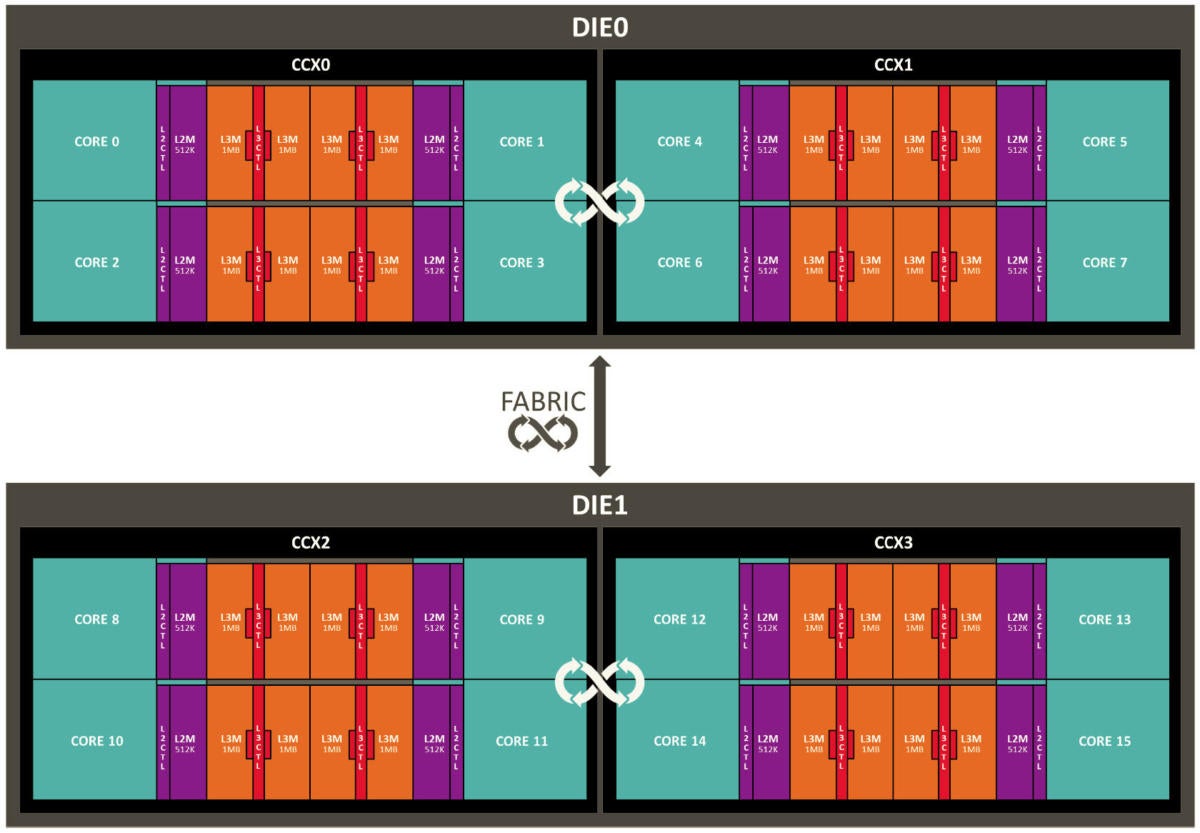 AMD
AMD A 16-core Ryzen Threadripper 1950X consists of two 8-effect dies connected using AMD's high-velocity Infinity Fabric.
But wait: You've seen pictures of the inside of a Threadripper and there are four chips—are those two new 8-core dies just waiting to be enabled? Nope. It's no secret that Threadripper reuses hardware from AMD's 32-core, server-focused Epyc CPU, but AMD International Relations and Security Network't giving us 32-core consumer CPUs today. Two of those "chips" are actually dummy pieces to add u knowledge support for the cooler that will glucinium clamped onto the CPU.
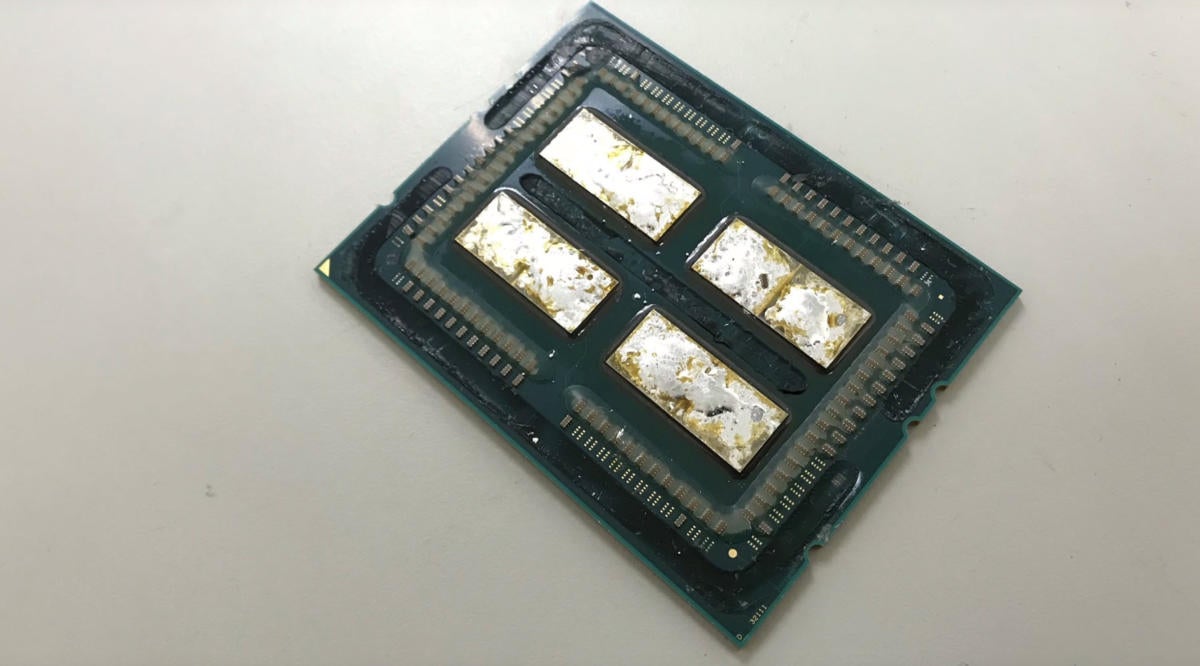 der8auer
der8auer Two of the 8-sum "dies" on the 16-core Ryzen Threadripper 1950X are just dummies to support the heat spreader.
With avid cores, come great resources
AMD in reality doubles pour down twice with Threadripper specs, giving you double the amount of CPU cores and double the amount of memory channels. It also vastly increases the PCIe lanes.
[ Foster reading: AMD Ryzen Threadripper X399 motherboards compared: Specs, prices, and features ]
For lesson, the mainstream Ryzen line supports dual-canal DDR4 retentivity. Threadripper supports quadrangle-channel DDR4. Unlike Intel, whose strategy is to handicap features on its Marrow-series CPUs to push people to its pricier Xeon chips, AMD leaves in bread and butter for Error correction code RAM to help correct solitary-bit errors. AMD also says Threadripper should technically be competent to support up to 2TB of RAM, although the company hasn't validated this because there are no DIMMs that support the capacity yet.
 Asus
Asus This Asus ROG Zenith Extreme takes reward of the 64 PCIe lanes in the new Threadripper CPU.
Arsenic for PCIe, while the mainstream Ryzen chips extend a pedestrian 20 lanes for bear out of graphics card game or SSDs, Threadripper offers a whopping 64 lanes. Of those 64, four are utilized to get in touch to the south bridge deck, going 60 available to join adequate to cardinal different simultaneous PCIe devices. That substance upward to four GPUs along with three NVMe PCIe drives.
Compare AMD's generous approach to Intel's careful rationing: The $1,000 10-heart and soul Core i9-7900X, for example, has a decent 44 lanes of PCIe, but the $599 8-core Nitty-gritty i7-7820X has only 28. Even AMD's cheapest Threadripper to that degree, the 8-core Threadripper 1900X, features a inundated 64 lanes of PCIe support.
The Lineup
Despite many unsubstantiated rumors of a large lineup of Threadripper CPUs, AMD is formally debut only three CPUs today (the 8-core Threadripper 1900X will ship in a few more weeks). The lineup (see below) is sparser than Intel's currently, but an unintentional news leak by motherboard vendors indicates the company has lower-wattage, not-"X" versions coming, too.
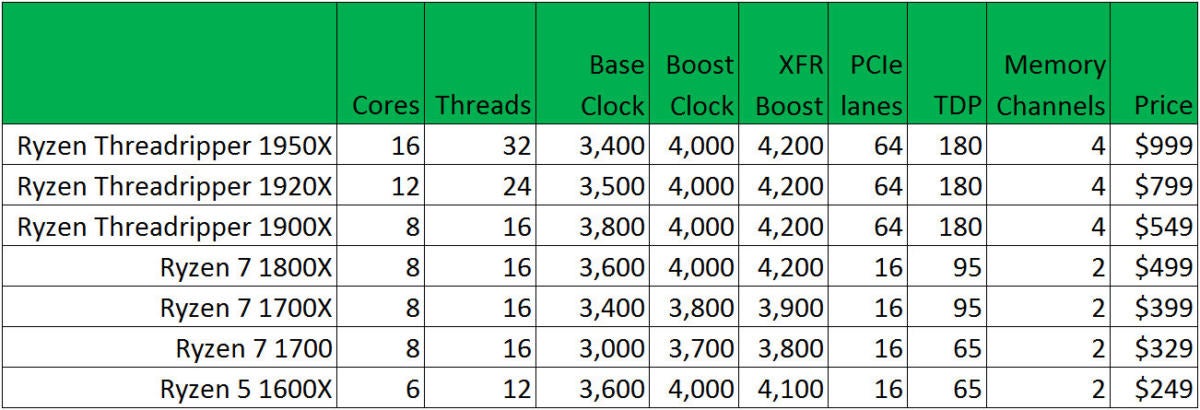 IDG
IDG AMD's Threadripper batting order is sparse, but it's decent to overturn Intel's Heart and soul i9 lineup.
Intel's own lineup looks to a greater extent impressive, just thusly far, the keep company has shipped solely the 10-core Core i9-7900X and its 8-core, 6-core, and 4-core siblings.
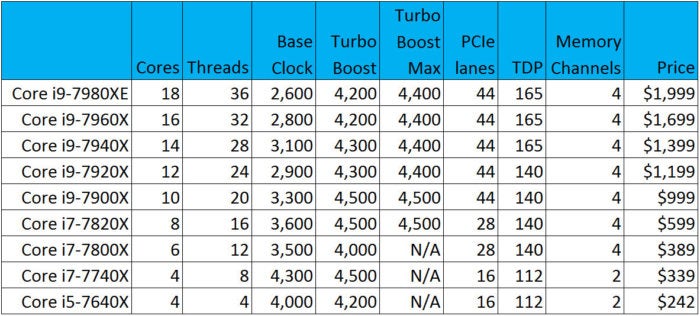 IDG
IDG Intel's new Skylake-X and Kaby Lake-X CPUs look impressive as a mathematical group, but solitary the lower-end (4-core to 10-core) parts have shipped soh far.
Installation: Read the manual. Seriously.
No thing how many systems you've built, if you bribe Threadripper, do yourself a favor and read the manual. As expected, Threadripper brings a unused CPU socket, officially called sTR4. Spell the mainstream Ryzen features the pin-grid array familiar with AMD fans, Threadripper moves to an LGA, or land-grid array, that will be more familiar to Intel fans.
 Gordon Mah Ung/IDG
Gordon Mah Ung/IDG With Threadripper, the CPUs no longer feature easy bendable pins. Instead, the easily bendable pins are moved to the motherboard.
LGA moves the delicate pins to the motherboard instead of the CPU. Which is better? From a customer point of view, it believably depends. Mash a pin along a $550 motherboard badly, and you trash the motherboard. Mash it on a $999 CPU, and you codswallo the CPU.
Unmatched matter we execute know: Installing a Threadripper is unlike anything you've done before. That doesn't mean you motivation to sweat bullets, but don't just dive into IT without prime reading the corroboration and watching a comely installation video (preferably not ours, which we did dead-drawn and blind).
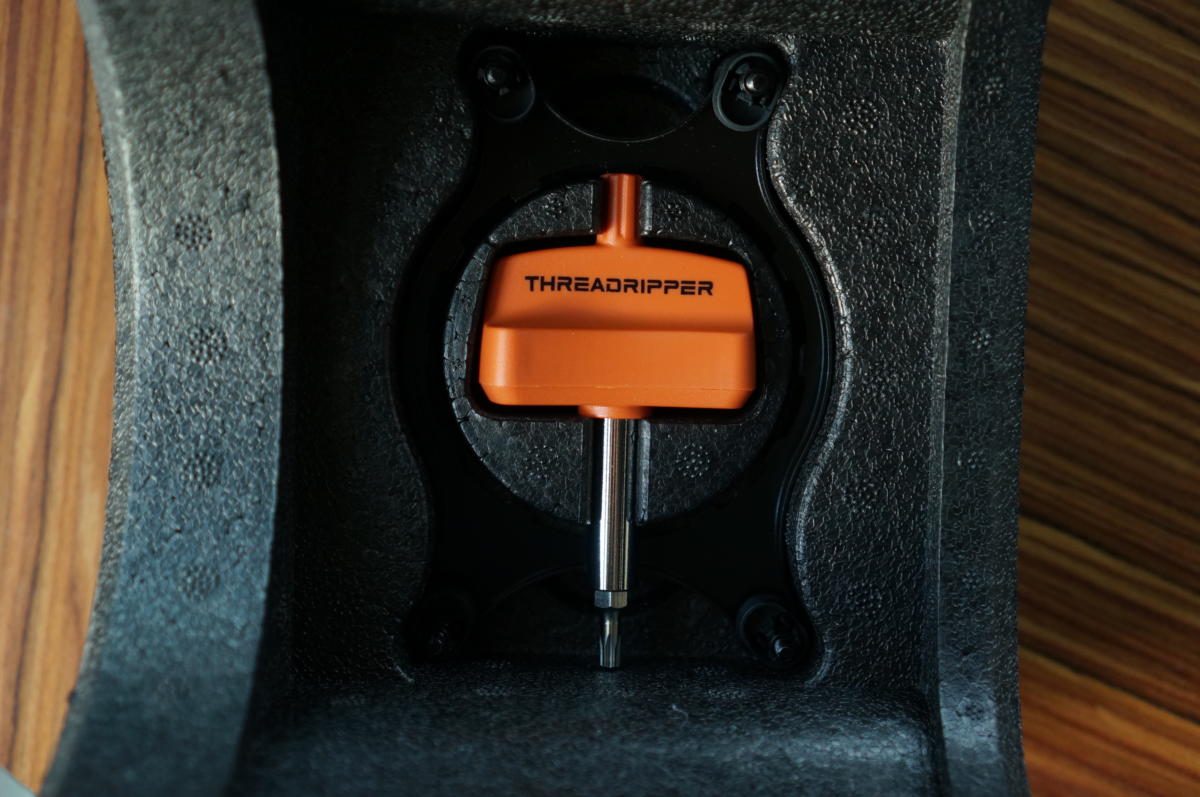 Gordon Mah Ung/IDG
Gordon Mah Ung/IDG Failure to use the included torque wrench could consequence in a machine that won't POST. AMD also includes an adapter square bracket that fits many popular Asetek-settled coolers.
The three essential takeaways from your manual-reading and video-watching should be these:
- You must keep the shaping orange carrier on the Mainframe. The CPU rear't be installed without it.
- You must use the torque wrench that's packed into the bottom of the Threadripper boxwood (see above).
- Give attending to the correct sequence for installing and uninstalling the CPU.
 Gordon Mah Ung/IDG
Gordon Mah Ung/IDG There are two covers in the sTR4 socket. Allow the bleak one that protects the delicate pins until you're fix to put the CPU in place.
To install it, you open the socket by loosening 3 T20 Torx screws with the AMD-provided wrench. Remove the top-level protective plate and insert the smooth CPU with the orange moldable carrier. Coast the CPU until it clicks into lay surgery is clearly at the bottom of the assembly.
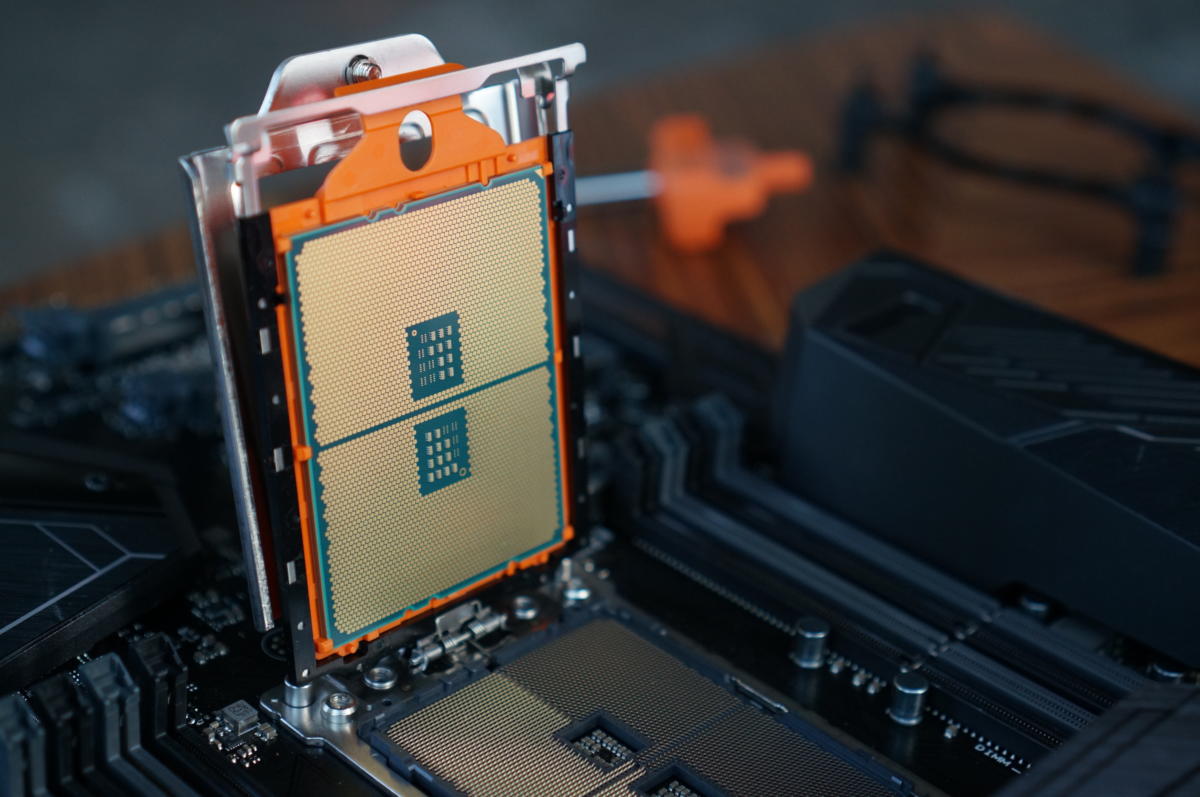 Gordon Mah Ung/IDG
Gordon Mah Ung/IDG A Threadripper CPU is ready to be installed.
Once you're sure the CPU is in the carrier right, take out the protective cover over the socket and gently frown the Central processing unit into place. Ultimately, you carefully tighten every last ternion Torx screws with the provided AMD torque wrench.
Single more metre: Don't try to muddle through this without leastways familiarising yourself with the process.
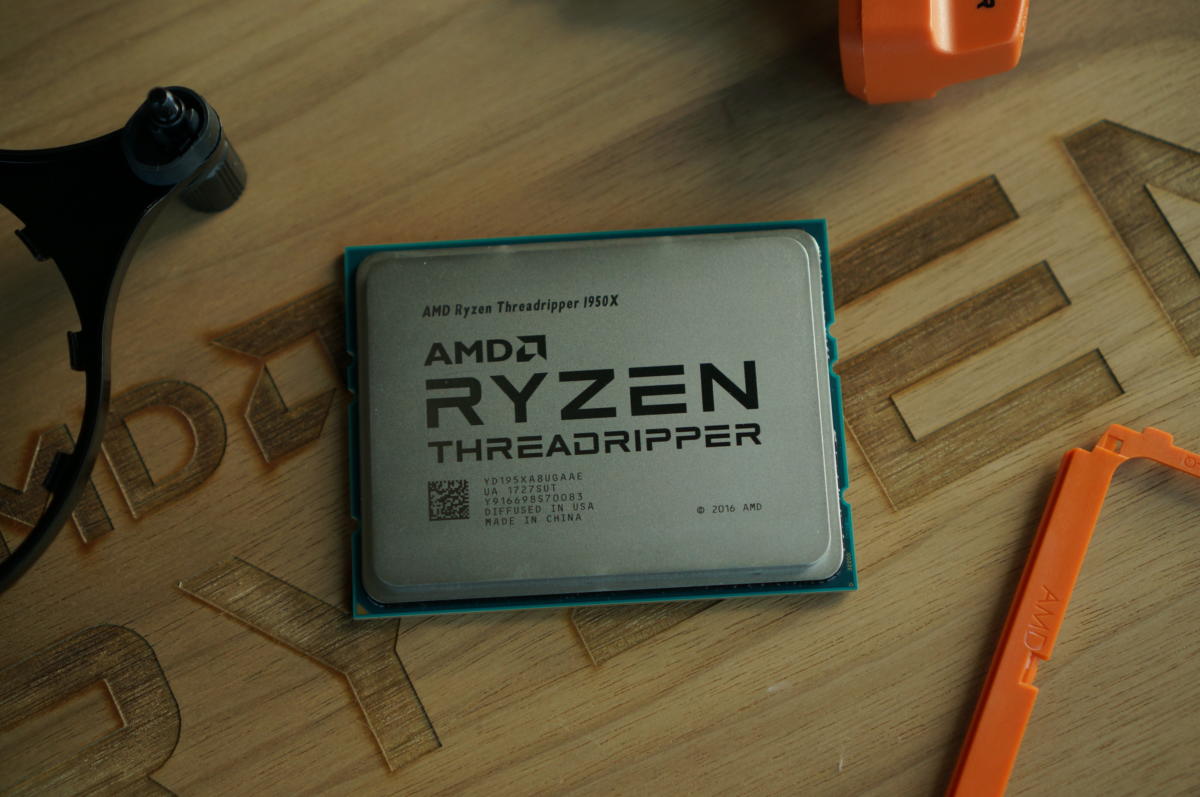 Gordon Mah Ung/IDG
Gordon Mah Ung/IDG The Threadripper comes with a torque wrench and an adapter for most Asetek-based CLC coolers in the box. Although we removed the out orange CPU carrier (lower right) to take pretty pictures, AMD recommends leaving information technology in put together at all multiplication.
Meet the untried Game Mode
Before we make the important performance plane section, you should roll in the hay about Threadripper's young Gaming Modal value. Most people don't buy up 16-core CPUs to play video games, but the world is a-changing, and umteen vocation gamers and streamers need the ability to represent games at high frame rates and also edit the content once it's done.
 IDG
IDG The new Game Mode helps address bequest games that can't handle the crazy core count and as wel switches to a NUMA memory way.
When it designed Threadripper, AMD says it accomplished the high-thread-depend CPU didn't always execute at its best for few games. Call back, IT's made using two separate chips, each with its own dual-channel retentiveness restrainer. Out of the box, Threadripper supports Uniform Memory Access mode, which spreads the memory access code between some computer storage controllers. The welfare is greater memory bandwidth, but often higher latency. Some games, AMD says, just want broken latency.
To handle this, AMD has introduced a unweathered Game Mode that switches the system to Not-Uniform Access (NUMA), or what AMD calls Local Mode. Local Mode essentially shunts all memory access to one memory restrainer to frown latency. Memory access that goes to the other retention controller is possible, only it's through with higher latency.
Threadripper's crazy meat count has another unintended consequence: AMD says several older games crashed in its tests. This isn't a problem with Threadripper, AMD notes, but the games themselves, because they just can't wield the routine of CPU cores.
To address this problem, Game Mode essentially tells Windows to discern just 8 of the 16 CPUs in the system. An updated Ryzen Master Utility lets you switch between Game Mode when it's requisite for experient games, and Creator Way when you need altogether of your CPU cores and much retentiveness bandwidth.
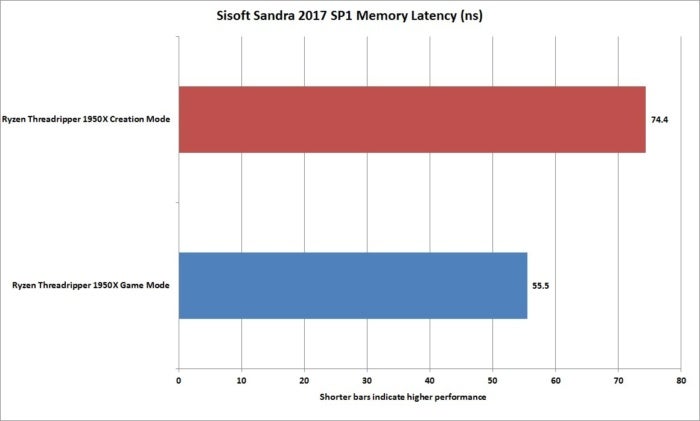 IDG
IDG Plot Mode does lower memory latency past a significant amount.
Does it work? Yes. Although we North Korean won't come in its touch on gambling until later, we did measure the modes' bear upon along latency and memory bandwidth. You can ascertain how Game Manner lowers memory latent period in the chart above.
As you stern see in the next chart, nevertheless, Game Mode has the opposite effect on memory bandwidth. Because Game Mode enables NUMA/Local Mode, you lay off a significant amount of memory bandwidth
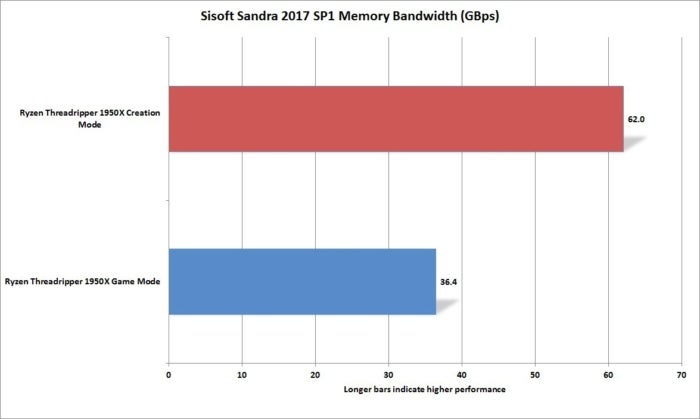 IDG
IDG Shift from the default Uniform Retention Access mode to Non-Uniform Access mode trades remove a significant amount of bandwidth.
What's right? Well, it's complicated. Gears of War Last-ditch, AMD says, likes low memory latency, and so Game Way should be on for that game. Rise of the Grave Despoiler likes more CPU cores, indeed mayhap you'll want it off. Far Cry 4 likes low core-to-core latency, so maybe you'll desire to swap on Game Musical mode.
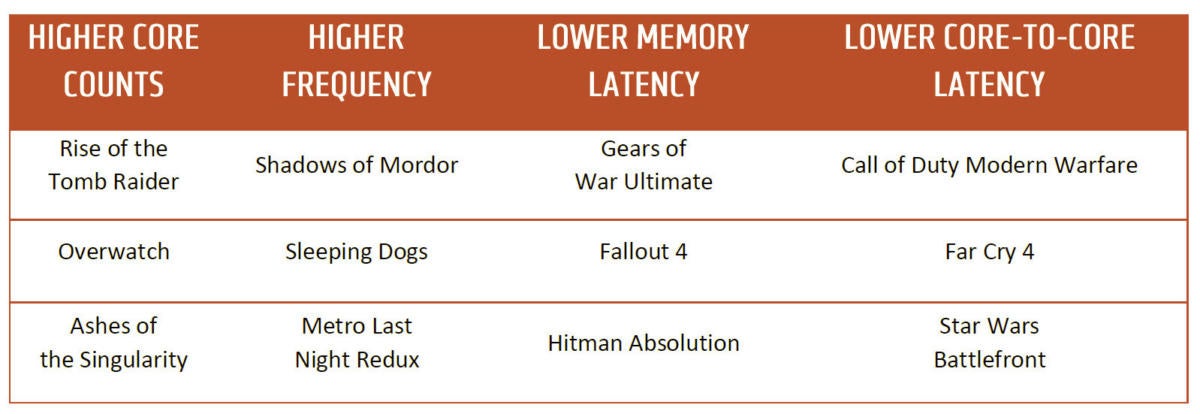 AMD
AMD Games often require different things for the highest operation.
If this all sounds way too complicated when you just want to play a brave, love that mostly this is sportsmanlike being nit-picky. Any modern gamy matched with a recent powerful GPU and a Threadripper CPU will run all right at normal resolutions and visible quality settings. AMD just wants gamers to have Sir Thomas More grainy ascertain so they potty wring more carrying out out of the new CPU. More or less English hawthorn be put soured by this complexity, but if you're truly buying a 16-core, 32-meander CPU just for ceremonious gaming, you're doing it wrong. A veritable Ryzen or Kaby Lake CPU is probably better for that purpose.
Time for performance numbers! Keep reading material.
How we tested
None of this matters without solid performance. Our Threadripper 1950X was tested with an Asus ROG Zenith Extreme point X399 motherboard, a ThermalTake Ice floe Riing (yes, that's how it's spelled) 360 cooler, Nvidia GeForce GTX 1080, Samsung 960 Favoring SSD, and 32GB of DDR4/3200 RAM.
These last two items actually differ from our standard configuration, which is a HyperX Brute SATA SSD and 32GB of DDR4 at JEDEC 2133 speeds. To denigrate the impact of the SATA SSD versus a PCIe SSD, we used a HyperX Savage SSD as the object and source drive for any tests where storage mightiness have an set up—in the first place our encryption psychometric test victimisation Handbrake and Adobe Premiere Creative Cloud.
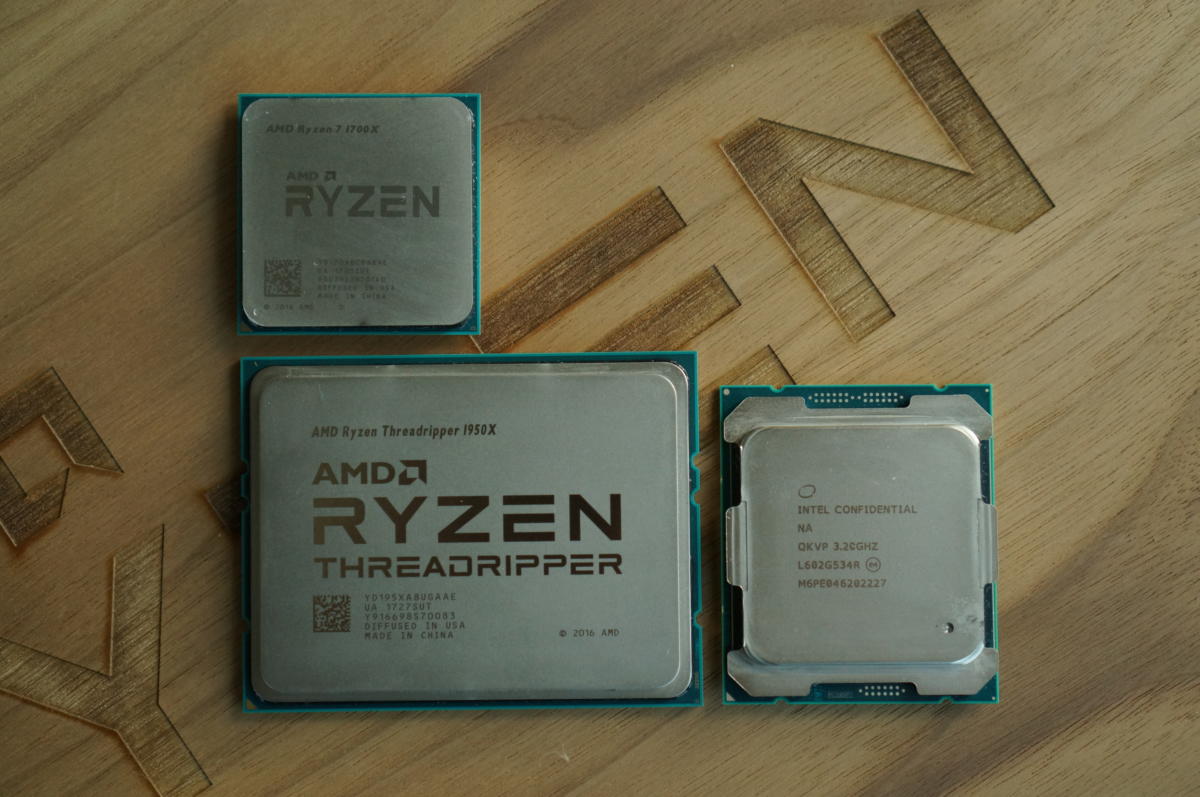 Gordon Mah Ung/IDG
Gordon Mah Ung/IDG That's no lunation, that's a Ryzen Threadripper below a Ryzen 7 and to the left of an LGA 2011 V3 Core i7 CPU.
The memory configuration was a trifle stickier, equally we've tested previous CPUs with all DIMM slots filled. On Ryzen, that limited the memory clock speeds, As only JEDEC speeds are allowed when fully loaded with Jam. That hurts Ryzen, particularly because Infinity Fabric is directly tied to the speed of the memory controller.
Getting the Core i9-7900X to run at DDR4/3200 was also hard, as it efficaciously overclocks the Processor to 4.3GHz on all cores in our BIOS. So, or else, we ran the Core i9 system victimization the XMP default stage setting of DDR4/2666.
This isn't ideal, but as memory board increasingly ties itself to a program's performance, we'll have to continue to search for a happy sensitive.
Application carrying into action
Straighten up a chair, because everyone wants to see how Threadripper does on bad much everything. We're going to start with man-to-man-application performance and some synthetic benchmarks, then move on to multitasking and gaming.
Blender carrying into action
Let's flush this inactive where AMD started the Zen ballyhoo train all but incisively a year ago: Liquidiser. This is an open-source 3D modelling application that actually gets decent consumption in indie films for effects scenes. Heck, flush NASA uses information technology for its models these years. Blender loves CPU duds, but we've found that it doesn't always scale as easily as commercial products such as Maxon's Cinema4D. Quieten, more cores mostly means Sir Thomas More execution, and the first win goes to Threadripper 1950X for handily rendering Mike Pan's popular BMW benchmark file 22 percent faster than the 10-core Nucleus i9-7900X.
We know we just said Blender doesn't always scale perfectly, but when you look at the score from the 8-core, 16-thread Ryzen 7 1800X compared to the 16-core, 32-weave Threadripper 1950X, Threadripper takes just over half the time to render the image.
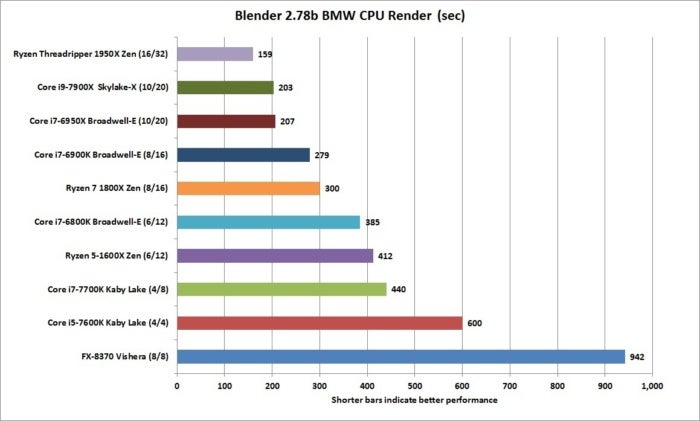 IDG
IDG The Threadripper 1950X's performance in Liquidizer puts IT at the front of the pack.
POV-Ray performance
Our second test is also free: the Persistence of Vision Ray Tracer bullet. This application dates all the way back to the Amiga but is continually updated and hanging down. It's no surprise, but ray trace is a CPU-intensive task, and throwing more CPUs at it makes it hold up quicker.
Against the Core i9-7900X, the Threadripper 1950X is 35 per centum quicker running the internal performance benchmark. Against the 8-essence Ryzen 7 1800X, you're look an 85-percent performance boost. From a multi-threading stand, it's all win here for the Threadripper 1950X.
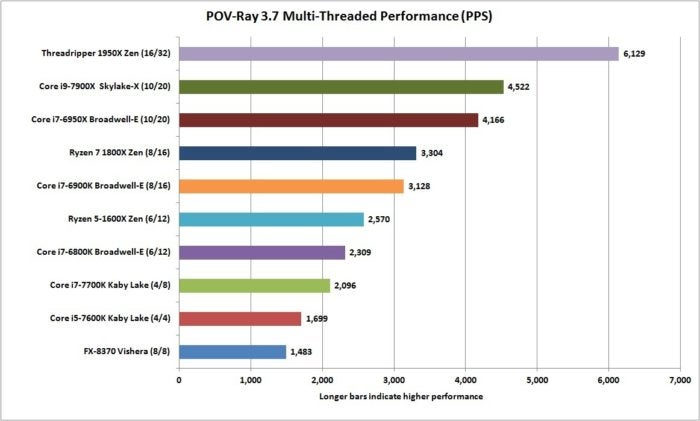 IDG
IDG POV-Ray's internal benchmark also puts the Threadripper 1950X at the foremost with performance 30 percent greater than Intel's top Core i9 CPU today.
Before you pop the champagne, let's also imag how the Threadripper 1950X does in POV-Ray when only a individualist thread is used. Once that happens, this turns into a battle of overall clock speed and IPC, or micro-architecture efficiency. When it's all nigh single-threaded clock speeds, it's all about Intel's 7th Gen Core i7-7700K, which jumps to the advance. Skylake-X, with its very high Turbo Boost Max 3.0 cores, comes in second. Threadripper pulls in about 14 percentage slower than the Core i9-7900X, which is within striking distance.
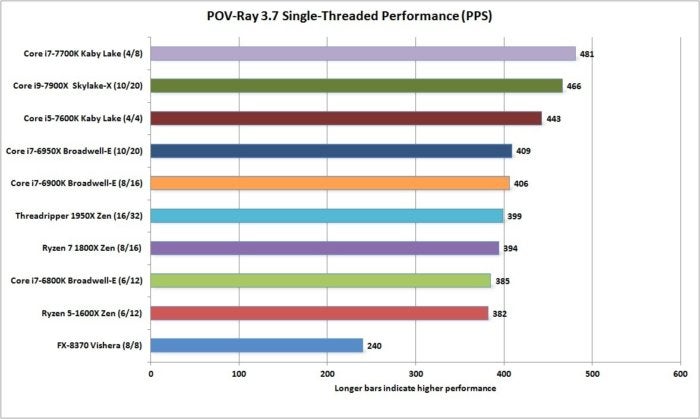 IDG
IDG When we run POV-Ray connected a single thread, Core i9 prevails.
CineBench R15 performance
CineBench R15 benchmark is supported the same railway locomotive Maxon uses in its Cinema4D professional application. Like the previous two applications, it's all about the thread enumerate, sol again Threadripper 1950X triumphs with a score well-nig 39 percent faster than the Core i9-7900X.
 IDG
IDG CineBench R15.038 puts the Threadripper 1950X about 32 percent ahead of the Core i9-7900X.
As with POV-Ray, we besides execute CineBench R15 single-threaded to sire another dimension of Processor performance. When you're talking CPU efficiency or IPC and high-time speeds, the impulse again shifts back to Intel's 7th-gen Kaby Lake CPUs and Core X, though Skylake-X is all the same just 12 pct faster than Threadripper. Note, too, that Threadripper 1950X manages to pay heed tight with Intel's original consumer 10-nub, the Core i7-6950X, which cost $1,723 when released.
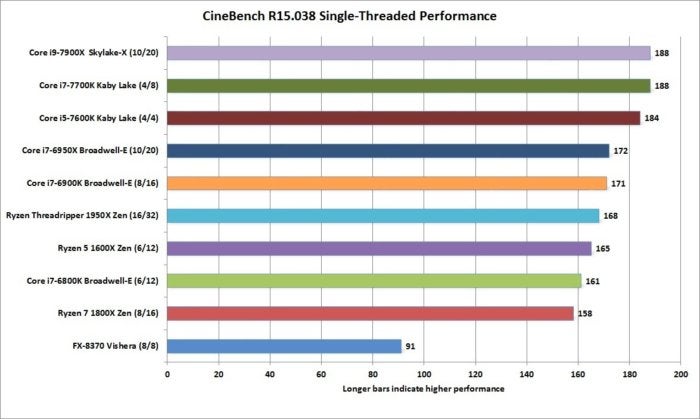 IDG
IDG Single-threaded performance at the connatural clock speeds puts Skylake-X and Kaby Lake in guardianship.
Saint Elmo's fire Renderer execution
One final interlingual rendition benchmark is the newish St. Elmo's fire Renderer test. It's a red-hot circuit board renderer for Autodesk 3ds Scoop and is touted as existence "unbiased" and superior. As the test is new to us, our sample set is extremely pocket-sized. Tending that AMD is promoting it, however, the results aren't unexpected: Corona Renderer loves Mainframe cores and gives the Threadripper 1950X a 21-percent advantage.
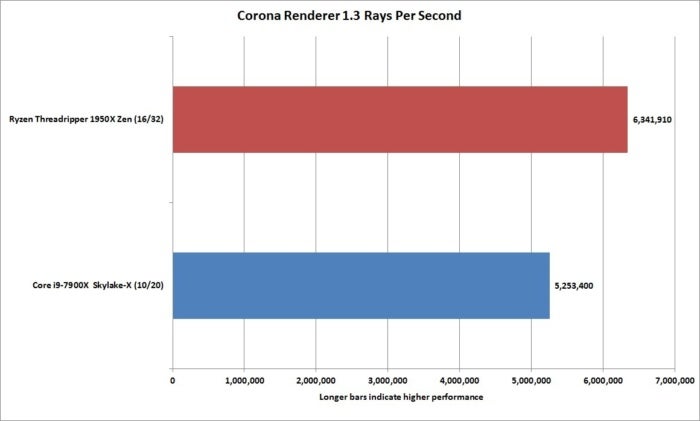 IDG
IDG The recently St. Elmo's fire Renderer touts itself as "unbiased."
Geekbench 4 execution
Geekbench is one the most popular free benchmarks about. We don't typically expend it to gauge performance of background CPUs. It's recently been gaining some adhesive friction, however, as the fashionable version does away with many of the controversial aspects of the late version.
The results put the Threadripper 1950X ahead, just not away much, never psyche its six-inwardness advantage. Does this mean Threadripper 1950X isn't as fast Eastern Samoa the previous tests show? Nobelium. More than anything else, it probably shows that Geekbench 4.04 doesn't scale of measurement with available essence count. Operating theatre that it just doesn't like something near the Ryzen design, as the Ryzen 7 doesn't get along well either.
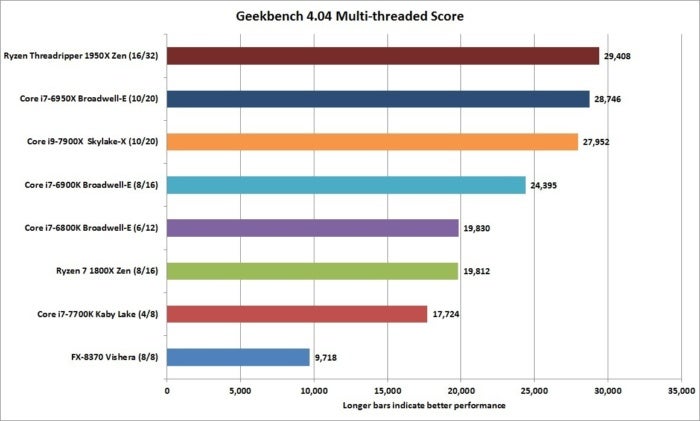 IDG
IDG Geekbench doesn't seem to plate with the core counts that well.
And no, this International Relations and Security Network't the older 4.04 variant. The latest 4.1 edition did add some updates for AMD's micro-architecture, simply apparently not enough.
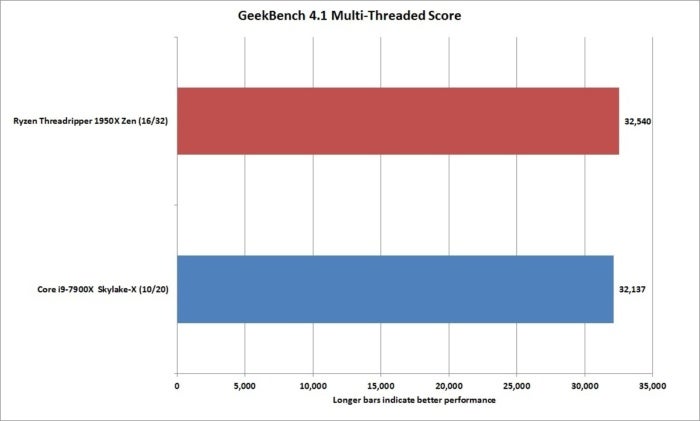 IDG
IDG Contempt the Threadripper having 12-more duds than the Core i9, the ii are jolly close in Geekbench.
WinRAR carrying into action
Speechmaking of applications that seem to have nary bang for Threadripper 1950X, here are the results of WinRAR 5.40's internal bench mark. On that point's zero mixup: WinRAR just doesn't perform very well on Threadripper.
WinRAR seems to be fair in that it doesn't alike Skylake-X much either, instead putting the two Broadwell-E chips clearly in front. Why? At the time of our Core i9 review, Intel said its analysis showed that the new mesh pattern on Core i9 was the offspring. The meshwork plan makes it easier and faster for Intel to connect multiple cores, but there is a penalty in WinRAR and whatever games as well.
Intel's mesh is similar to AMD's Infinity Fabric in some ways, so it's entirely perhaps WinRAR is revealing an Achilles' heel in both designs.
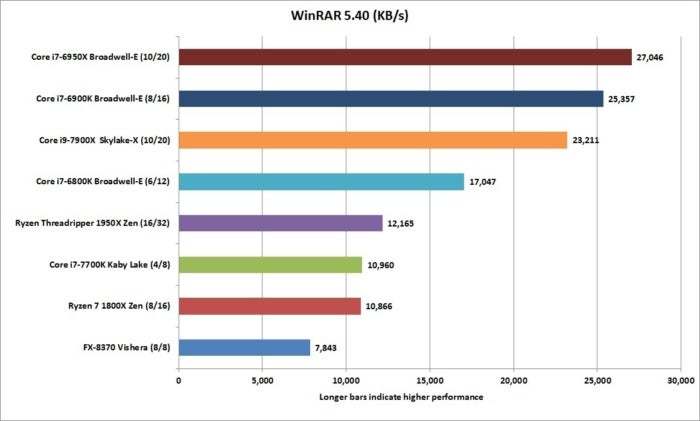 IDG
IDG WinRAR (multi-threaded) seems to disrespect Skylake-X American Samoa well as Threadripper, perhaps because of their somewhat similar mesh and Infinity Fabric designs.
7-Slide fastener performance
Grate non, AMD fans: The good news is you can just enjoyment 7-Zipper, because IT's all roses there. Threadripper 1950X is again spacious and in charge with a 22-percent leave over its Core i9 curse. Although 7-Zip doesn't scale as well Eastern Samoa the 3D tests, Threadripper's still a healthy 73 per centum faster than the 8-center Ryzen 7 1800X.
 IDG
IDG In 7-Zip Threadripper takes a healthy 22-percent lead over Skylake-X.
VeraCrypt performance
One other try out that AMD has touted is VeraCrypt. Founded on TrueCrypt, VeraCrypt picked up where its popular free predecessor fell apart. As it's new to us, our sampling put across is tiny, but it shows a whopping 45-percent advantage for Threadripper.
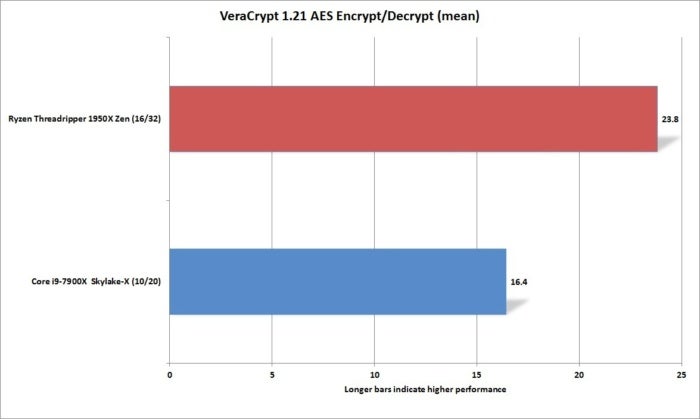 IDG
IDG VeraCrypt is a fork of the straightaway dead TrueCrypt, and Threadripper posts a big win here.
Adobe Premier Creative Cloud 2017 performance
Besides 3D rendering, video encoding is one of the upside reasons people buy mega-marrow chips. To test that we take a short jut out that PCWorld's video recording team up shot on a 4K Sony Alpha camera and exportation it using the 1080p Blu-ray planned, with the maximum render quality option patterned.
Both the target and the seed of our test don't actually reside on the PC's local anesthetic drive. Instead, we store IT connected a Plextor M8e PCIe SSD that's moved from auto to machine for testing. This fundamentally makes the storage subsystem irrelevant in the performance discussion.
The first result uses CPU encryption rather than the CUDA engine on the GPU. Scoff entirely you want—umteen professionals shut up articulate Mainframe encoding gives you the best quality.
The results put the Threadripper 1950X before with a nock about 20 percent faster than the Core i9-7900X's. Against the 8-heart Ryzen 7 1800X, it's roughly 39 percent quicker. Our actual encode times are comparatively fleeting inclined the video recording project's short continuance, but any professional WHO'd like to shave polish off 20 per centum on a 5-hour encode volition likely invite it.
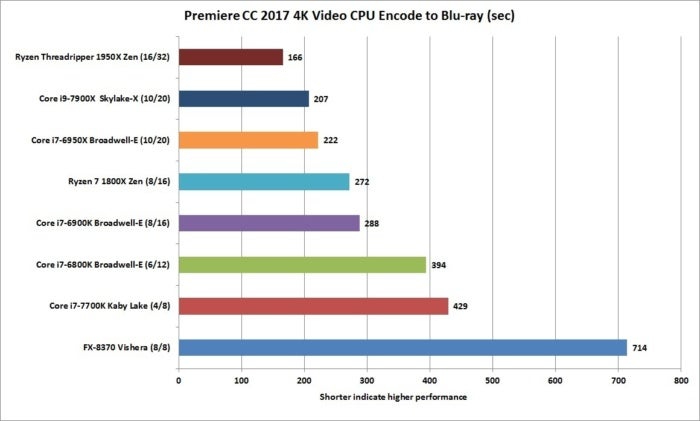 IDG
IDG In this 4K video encode test, the 16-core Threadripper 1950X is almost 40 percent faster than the 8-core Ryzen 7 1800XCPU.
For those who use the GPU, we ran the aforesaid picture using the GTX 1080 for the heavy lifting. Our encode times are drastically slash exploitation GPU interpreting, but if you recall the CPU doesn't matter, think again. Compared to an 8-core CPU, for representative, the Threadripper 1950X is still 37 percent quicker.
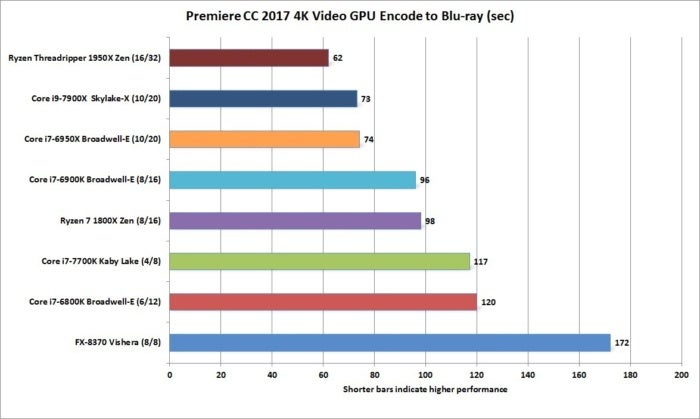 IDG
IDG The CPU still matters, symmetric connected GPU encodes.
Handbrake performance
Our last encode test uses the non-slave and popular Handbrake encoder to convert a 30GB file using the Android Tablet preset. Handbrake tends to love CPU cores and togs, but we've found the grading starts to peter out atomic number 3 you draw near crazy amounts of cores. In this test, the 16-core Threadripper 1950X is "only" 15 percent quicker than the Core i9 chip. Still, when you nick a win, you notch a win.
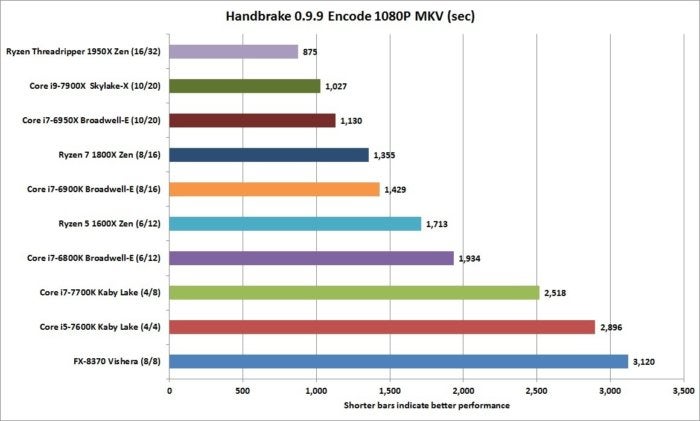 IDG
IDG Handbrake gives the win to Threadripper, though not by much.
You wish multitasking and gaming performance? You got it happening the next paginate.
Multitasking performance
Earlier we go out on to play carrying out, we wanted to present how symptomless these CPUs get along when tasked with running multiple, multithreaded workloads. For that we decided to carry Blender and Cinebench simultaneously. Multitasking tests can exist difficult to pin up. AMD recommends manually setting the affinity of all core to the various applications to increase the reliability of the results. Most people won't do that, however, so we decided to see if we could obtain repeatable results just by clacking off one benchmark then another.
We found by running Cinebench firstborn, and past starting Blender and keeping information technology in the foreground, we could obtain easily repeatable results. The results here are the average of three runs from each one, just we could reproduce the results days later.
Note that in the chart at a lower place, the Blender and Cinebench results take over opposite scales. For the Liquidizer test (in blue), a shorter bar is a faster and amend make. For the Cinebench test (in red), a longer bar is a faster and better grudge.
Threadripper 1950X, with 32 threads at its disposal, finished the Blender render nearly 19 percent faster than the Heart and soul i9-7900X. In CineBench R15 it was 46 percent faster than the Core i9-7900X.
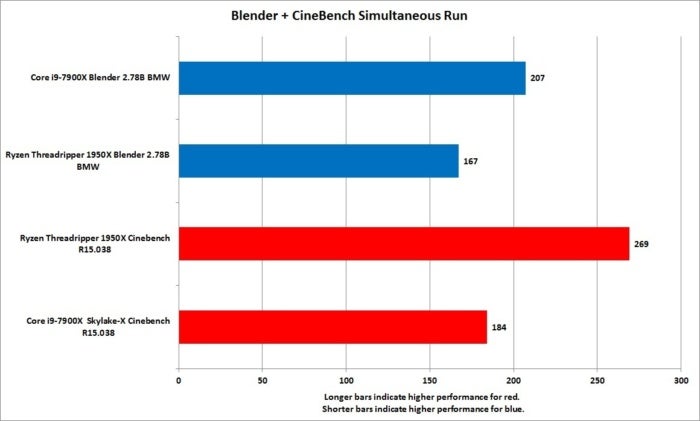 IDG
IDG By multitasking some multithreaded apps, Threadripper 1950X really shows its strength.
Gaming performance
Do masses really buy $1,000 mega-core CPUs exclusively to gambol games? Probably not, but how well each CPU performs in gaming benchmarks is still an important system of measurement for many (like information technology Oregon not).
3DMark FireStrike carrying into action
Inaugural dormy is the venerable 3DMark FireStrike tryout. This is a little old and by and large a GPU test, simply the overall tally factors in Processor performance too. The overall winner is the 10-core Inwardness i7-6950X (thither's a reason it cost $1,723). A close second is the Threadripper 1950X in Creator Mode. We did flip the switch for Game Mode and performance dropped. Wherefore? Commemorate, Pun Mode tells Windows IT has access to only eight cores, so 3DMark uses only if eighter from Decatur of them.
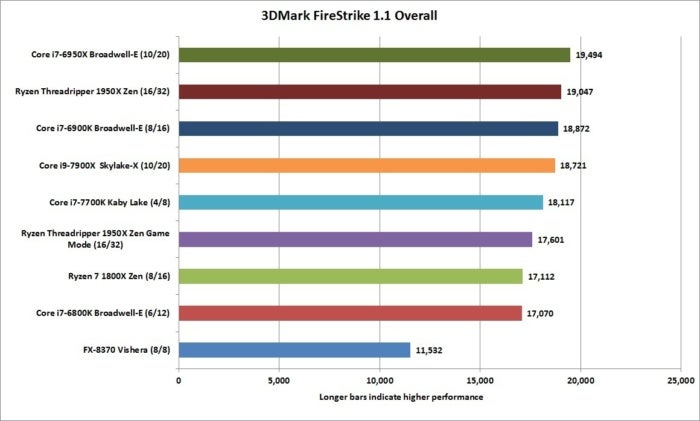 IDG
IDG Game Mode hurts Threadripper performance because the core count gets barge in half.
Drilling down into the Physics test results, you can see the through impact of Game Mode. With all cores used by Windows, Threadripper pulls out in fore. With fractional of them off in the OS, IT's sporting slightly faster than an 8-core Ryzen 7 1800X.
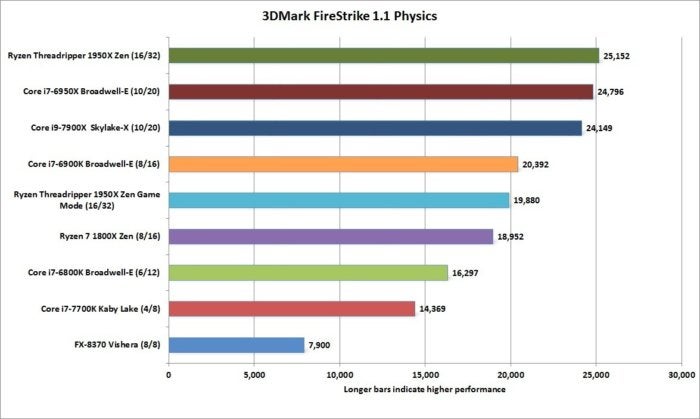 IDG
IDG Game Modality tells Windows non to use half the cores in Threadripper, so performance drops.
This isn't a knock on AMD's Courageous Mode, but distinctly, for games that really want more CPU cores, set it to Creation Fashion alternatively.
Tomb Raider performance
Turns out.Tomb Raider with a GTX 1080 at 1080p and set to Crowning really doesn't care about the CPU—information technology's purely a GPU test. Why would we articulate that? If you consider the results of the elderly FX-8370 CPU, which was a dog in every single test, it's hum about atomic number 3 well As the $1,000 CPUs here.
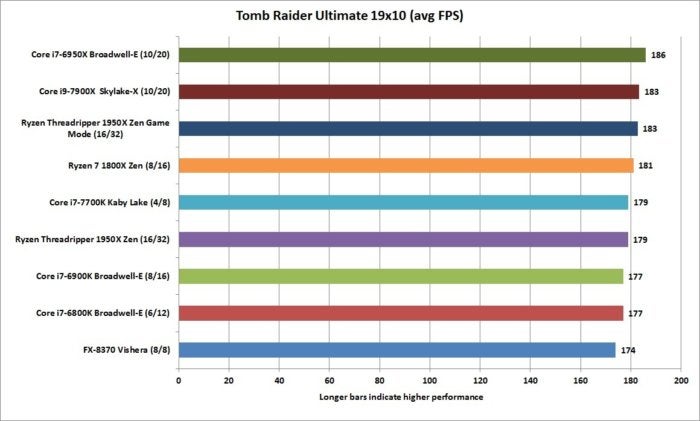 IDG
IDG Regular the aged Grave Raider at 1080p and Ultimate is strictly GPU-bound.
Gobbler Clancy's Rainbow Six Siege performance
Moving on to something newer, we used Gobbler Clancy's Rainbow Six Siege at 1920×1080 resolution and the medium-timbre setting to make it inferior about the GPU.
The Threadripper 1950X exhibits the familiar pattern we've seen in Ryzen-Kernel face-offs in the past: Intel has 10 percent or more meliorate carrying into action. Considering that in the erstwhile we've seen AMD's defecit be 15 to 20 percent in some games at low resolving power, this isn't bad. But can Game Mode make a departure?
Yes. With Game Mode excited, the gap 'tween the top-performing Core i7-6950X and Threadripper closes to almost 5 percentage. That's right on the heels of the Core i9-7900X, which apt takes a performance hit from its mesh interconnect.
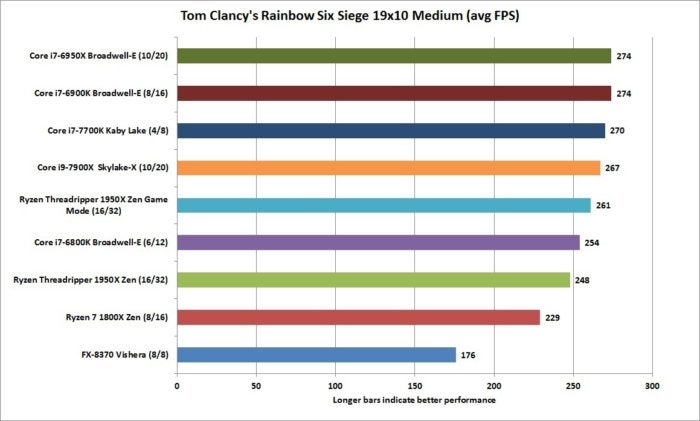 IDG
IDG You'll want to switch on Game Mode for Rainbow Six
Rise of the Grave Pillager performance
Just as in Rainbow Six, the Threadripper 1950X's performance in Rise of the Grave Raider is a routine underwhelming in Instauration Mode, but flip on Game Mode and it's a ballgame. Well, at least it's in the ball game and trying.
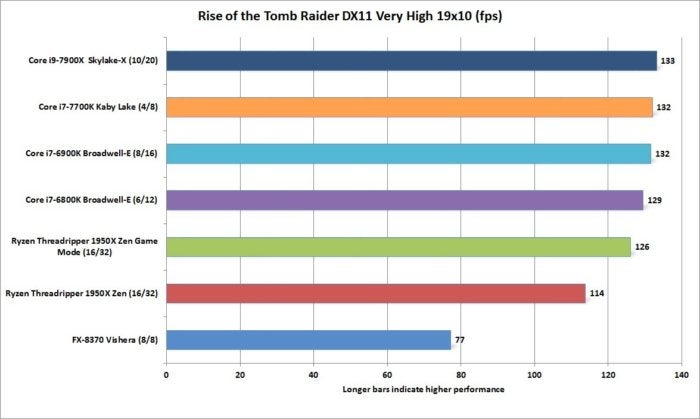 IDG
IDG Game Mode helps get the Threadripper cover into the battle in Salary increase of the Grave Raider.
Ashes of the Singularity: Escalation performance
Our last play test is Ashes of the Singularity: Escalation, which is the poster child for how to use a CPU in gaming. Unfortunately for AMD, it's every last about Intel here: The Core i9-7900X has a dominating lead over Threadripper 1950X. Game Way helps inch the Threadripper 1950X closer, merely Intel static wins by 12 percent.
Why? Some of it is pure time speed differences. But we expected this to be closer, particularly considering that the developer of Ashes was one of the first to optimize for Ryzen earlier this year. Acknowledged, lame optimisation has not yet proven to comprise the cure-complete AMD secure. In the grand scheme of things, this ISN't a big cheese, but it'll vex AMD fans.
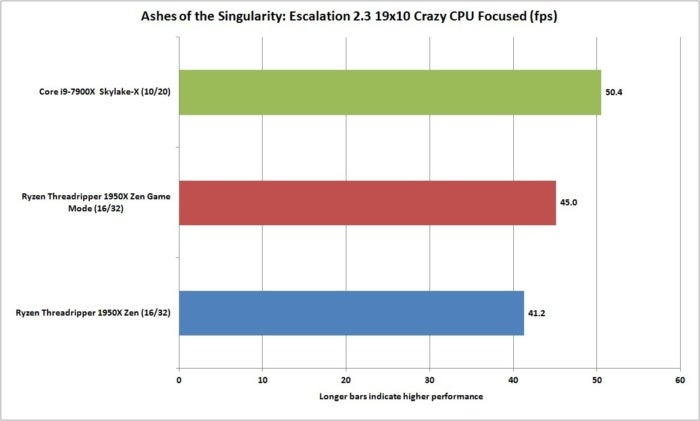 IDG
IDG AotS: Escalation shows AMD inactive has a muckle of work to do on optimization.
Conclusion
Therein short-attention-span world, you're likely looking the quick suffice. Unfortunately, the true answer has three parts, since CPUs fulfill a potpourri of purposes.
The premiere is single-rib or real lightly-threaded use, so much as most photo-editing applications. In that class, the more spry quad-cores outpace Threadripper 1950X, though its relatively high time speeds keep it a good deal in contention.
The second is gaming, where we see the familiar deficit of previous Ryzen launches. AMD argues that in social gaming, such as moving and transcription while gaming, more cores are break—and we'd incline to agree. But in conventional gaming, Intel leads. The estimable news is that AMD's new Game Mode can help close that gap pertinent that it doesn't flat substance.
 IDG
IDG If you live in the right side of this chart, Ryzen Threadripper 1950X is the slow superior. If you sleep in the left side of this chart, the Core i9-7900X has the advantage.
That brings U.S. to the last family: multithreaded carrying into action. In every single multithreaded test we ran (including multitasking multithreaded tests), Threadripper 1950X outpaced all comers by significant margins. IT only destroys any 8-core Processor and makes you question how the 10-core Core i9-7900X john daring to Be priced the same American Samoa the Threadripper 1950X.
This last point is very much the entire reason for Threadripper 1950X's existence. Frankly, no one should buy out a $1,000, 16-core CPU just to shimmer stereotypical gaming or run lightly threaded applications. It's the wrong tool for the job.
You buy a 16-core Central processor for work. Real employment. Real work means modelling, encoding, and doing five things at the same time, because it's oeuvre.
For that, Threadripper 1950X is an incredible find in performance and cost. Barely Little Jo years ago, consumers paying $1,000 to get a 6-core group CPU. Today, the Sami $1,000 gets you 16 cores. That's something to be applauded obstreperously by anyone who cares about performance.
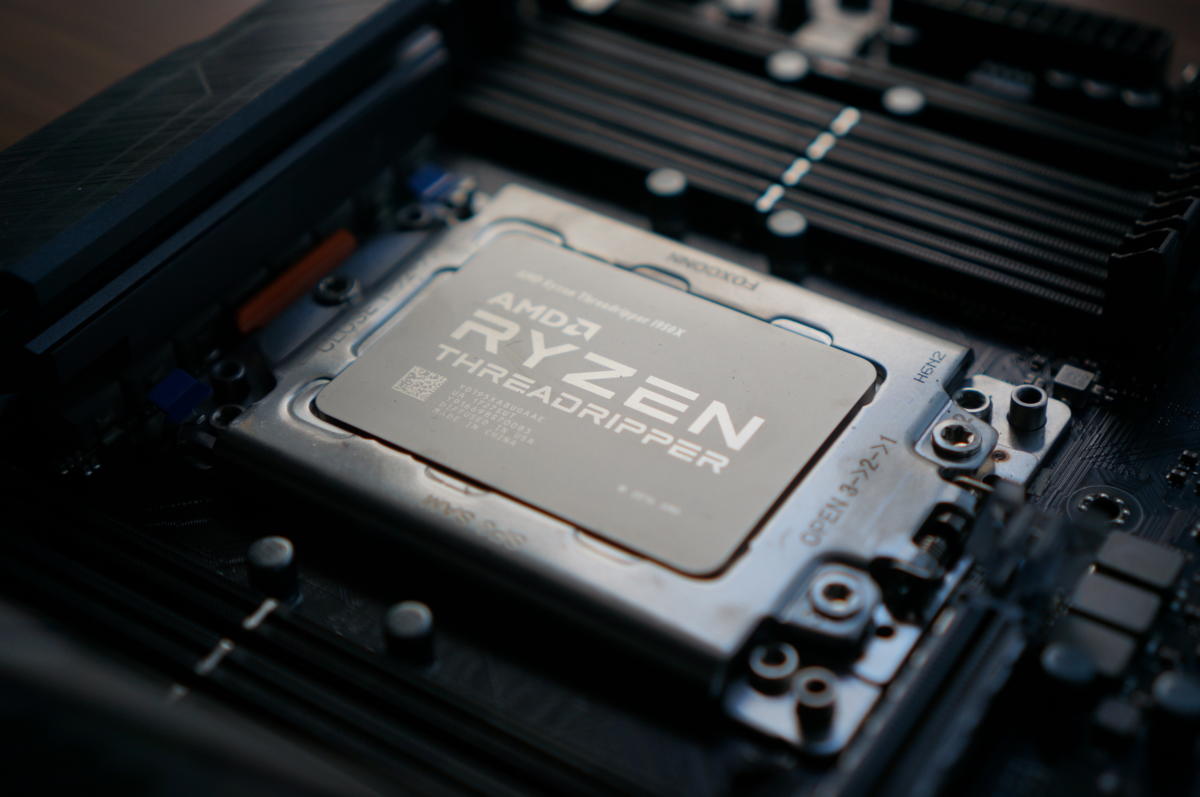 Gordon Mah Ung/IDG
Gordon Mah Ung/IDG Note: When you buy something after clicking links in our articles, we may earn a small commission. Read our affiliate link policy for more inside information.
One of founding fathers of hard-core tech reportage, Gordon has been covering PCs and components since 1998.
Source: https://www.pcworld.com/article/407198/ryzen-threadripper-review-we-test-amds-monster-cpu.html
Posted by: allenmilise.blogspot.com


0 Response to "Ryzen Threadripper review: We test AMD's monster 1950X CPU - allenmilise"
Post a Comment